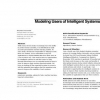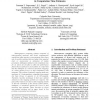1414 search results - page 126 / 283 » Randomness and Universal Machines |
CORR
2007
Springer
13 years 10 months ago
2007
Springer
We show that physical devices that perform observation, prediction, or recollection share an underlying mathematical structure. We call devices with that structure “inference de...
ICS
1997
Tsinghua U.
14 years 2 months ago
1997
Tsinghua U.
Modern microprocessors can achieve high performance on linear algebra kernels but this currently requires extensive machine-speci c hand tuning. We have developed a methodology wh...
CHI
2011
ACM
13 years 1 months ago
2011
ACM
While many devices today increasingly have the ability to predict human activities, it is still difficult to build accurate personalized machine learning models. As users today wi...
IPPS
2005
IEEE
14 years 3 months ago
2005
IEEE
Heterogeneous computing systems composed of interconnected machines with varied computational capabilities often operate in environments where there may be sudden machine failures...
CVPR
2009
IEEE
15 years 5 months ago
2009
IEEE
Many computer vision problems can be formulated in
a Bayesian framework with Markov Random Field (MRF)
or Conditional Random Field (CRF) priors. Usually, the
model assumes that ...


